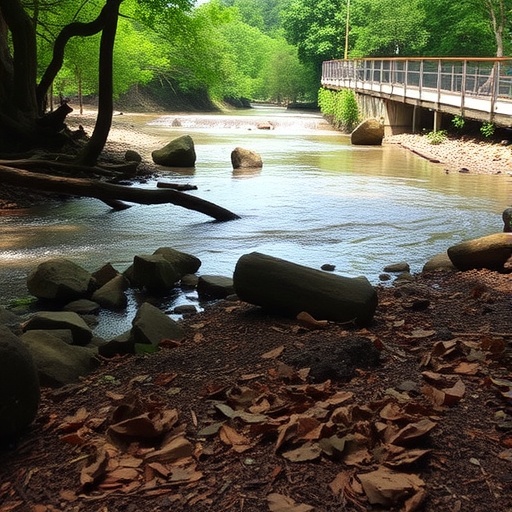Groundwater serves as a crucial resource for communities worldwide, providing essential water supplies for drinking, agriculture, and industry. However, this invaluable asset is increasingly threatened by various forms of contamination. Recent research conducted in the Rio das Velhas Basin, a vital watershed in Brazil, sheds light on the complexities of groundwater contamination, specifically focusing on multiple metal(oid)s and their associated risks. This study presents a detailed risk assessment and a multi-criteria ranking system intended to better understand and mitigate the dangers posed to this critical resource.
The Rio das Velhas Basin is particularly significant due to its ecological, social, and economic importance. It is a key supplier of water to millions of people, yet it faces persistent pressures from industrial activities, urban development, and improper waste disposal. These factors contribute to the degradation of water quality, raising concerns over the health and wellbeing of communities dependent on this vital resource. The presence of metal(oid)s, specifically, poses grave risks as they can be harmful at both acute and chronic exposure levels.
In the study led by Candido and colleagues, researchers undertook a systematic approach to assess the contamination risk posed by various metal(oid)s in the groundwater of the Rio das Velhas Basin. They utilized a combination of field sampling, laboratory analysis, and cutting-edge analytical techniques to characterize the types and concentrations of contaminants present. This comprehensive strategy enables a better understanding of the contamination’s scale and the different pathways through which these pollutants affect groundwater quality.
To effectively assess the risk associated with metal(oid) contamination, the researchers employed multi-criteria decision analysis (MCDA). This methodology allows for a nuanced evaluation of multiple factors influencing contamination risk, considering both environmental thresholds and human health standards. By integrating these various criteria, the researchers could highlight which metal(oid)s represented the greatest threat and prioritized actions to address these risks effectively.
The study’s findings revealed that several metal(oid)s were present at concerning levels within the groundwater of the basin. Among these, lead, cadmium, and arsenic emerged as particularly worrisome, each exhibiting distinct behaviors in terms of mobility, bioavailability, and toxicity. The presence of these contaminants underscores the complex nature of groundwater pollution, wherein multiple factors interact to exacerbate the situation and complicate remediation efforts.
Moreover, the study highlighted the dynamic interactions between various environmental variables and the contaminant profiles identified. Groundwater flow patterns, alongside regional geology and hydrology, contribute to the distribution and concentration of metal(oid)s in the aquifer system. Understanding these interactions is paramount for developing targeted management strategies aimed at reducing contamination levels and protecting public health.
Additionally, the research emphasizes the importance of continuous monitoring of groundwater quality, especially in areas experiencing rapid urbanization and industrial expansion. A proactive approach to groundwater management is essential to anticipate potential contamination events, develop mitigation strategies, and engage local communities in conservation efforts. By prioritizing environmental health, researchers can inform policymakers, stakeholders, and the public about the risks associated with groundwater contamination and the need for effective regulatory frameworks.
The implications of this research extend beyond just the Rio das Velhas Basin; they resonate with numerous regions worldwide facing similar challenges. The methodology and findings serve as a vital framework for other regions looking to assess their groundwater quality and identify contamination risks. As global populations increase, the sustainable management of freshwater resources like groundwater has never been more critical.
In conclusion, the study by Candido et al. sheds vital light on the multifaceted challenges of groundwater contamination in the Rio das Velhas Basin. By assessing the risk posed by metal(oid)s and employing a systematic approach to decision-making, the research illustrates the urgent need for comprehensive strategies addressing both environmental sustainability and public health concerns. Through continued research, monitoring, and community engagement, it is possible to forge a pathway toward cleaner, safer groundwater resources that can sustain both current and future generations.
The research stands as a clarion call for broader awareness and action regarding the protection of vital water resources. As the global community grapples with the realities of environmental degradation, the insights from this study could fuel not only local initiatives but also an expansive dialogue on water safety and contamination globally. Adopting a multi-faceted approach that incorporates scientific research, community involvement, and regulatory changes will ensure the preservation of one of our planet’s most precious resources.
While this research specifically targets the Rio das Velhas Basin, it highlights universal themes of environmental stewardship, scientific inquiry, and the socio-economic dynamics of water management. As more studies emerge, the hope is that lessons from the Rio das Velhas can inspire broader action across the globe, paving the way for a sustainable future where clean water remains accessible to all.
Subject of Research: Groundwater contamination by multiple metal(oid)s in the Rio das Velhas Basin.
Article Title: Risk assessment and multi-criteria ranking of groundwater contamination by multiple metal(oid)s in the Rio das Velhas Basin.
Article References:
Candido, A.L.Q., Ferreira, D.B., Amaral, M.C.S. et al. Risk assessment and multi-criteria ranking of groundwater contamination by multiple metal(oid)s in the Rio das Velhas Basin.
Environ Sci Pollut Res (2025). https://doi.org/10.1007/s11356-025-36851-0
Image Credits: AI Generated
DOI: 10.1007/s11356-025-36851-0
Keywords: Groundwater, contamination, metal(oid)s, risk assessment, multi-criteria decision analysis, Rio das Velhas Basin, environmental sustainability, public health, water management.




